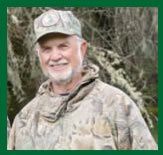Turkey Hunting Tips
by Terry Knight
The following is a common scenario for W.U. turkey hunters.
You have been out on a couple of W.U. ranches and heard a
turkey gobble at one but haven’t seen a bird on the other one.

You’re getting discouraged and think there are few or no wild turkeys on the ranches. It’s the type of call I receive from W.U. hunters every year. They’re convinced that they have wasted their time and the turkey hunting is poor. Nothing could be further from the truth.
The trick is to find them and then call them in.
All the ranches that W.U. has open for turkey hunting have huntable populations of birds. The trick is to find them and then call them in. Of course, that often takes a little effort on the part of the hunter. Hunting turkeys can be one of the most frustrating hunting sports. This is especially true on ranches where the birds have been hunted for a few years. A rule of thumb is that of all the gobbles you may hear, you will see fewer than 50 percent of those birds. Typically a tom will gobble a number of times and then just walk off.
On any given ranch most of the turkeys will be located in just a few areas. I have seen ranches that were 10,000 acres in size with several hundred turkeys, yet most of those birds will frequent only a third of the ranch. The trick is find that third where the birds are.
One method of locating turkeys is to hike to the highest hill and then make a call. Use a box call which has a lot of volume and make a series of loud yelps. The chances are that if a gobbler is within hearing distance he will gobble back. I have had old toms gobble back at me from a distance of up to a half-mile. If you don’t get a response go to the next hill. Repeat this calling until you hear a gobble. Mark the location and work your way to the turkey but don’t get too close. Set out your decoy, get under cover and start calling.
Start with a series of yelps. If the tom gobbles back, stay quiet for a few minutes and then give a series of softer yelps. You just want to call enough to keep the turkey interested in you. As the turkey gets closer, quit calling altogether. You want the tom to look for you.
Another method is set up in an area that you believe holds turkeys. Get comfortable and give a series of yelps. If you don’t get a response wait five minutes and repeat the call. I have often stayed in the same area for four or even five hours, calling every five minutes. Sooner or later the chances are excellent that a tom will respond. This is also a good opportunity to use a blind. A blind hides your movement and the modern ones can be set up in minutes.
Toms will often come in silently to a call. Many times I have had an old tom sneak right up to me, which is another reason to remain perfectly still. Just because you don’t hear a gobble doesn’t mean a tom is not on his way to you.
If you’re using a decoy, set it out about 25 yards from you. Make sure the decoy is in an opening where the turkey can see it. The good part about using a decoy is that it takes the turkey’s attention away from you.
Also plan on hunting all day. That means being in the woods at least an hour before daylight and staying until the 4 p.m. quitting time. Studies have shown that 75 percent of the hunters quit by noon. Remember you can’t shoot a bird while sitting in camp; you must be out in the woods. In other words, pack a lunch and water and stay out all day.
I predict that if you only select one W.U. ranch and stick with it, the chances are excellent that you will bag a turkey.
